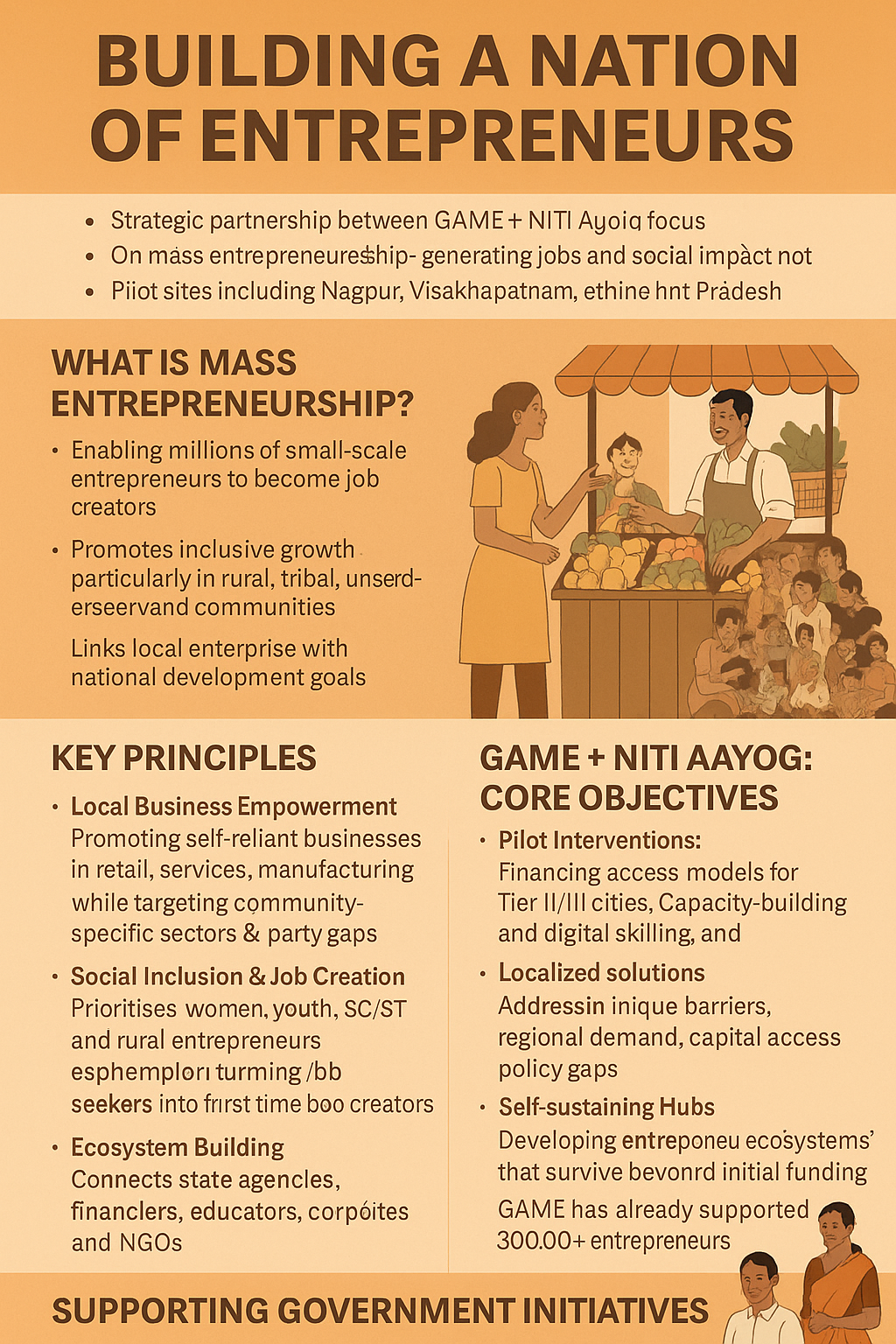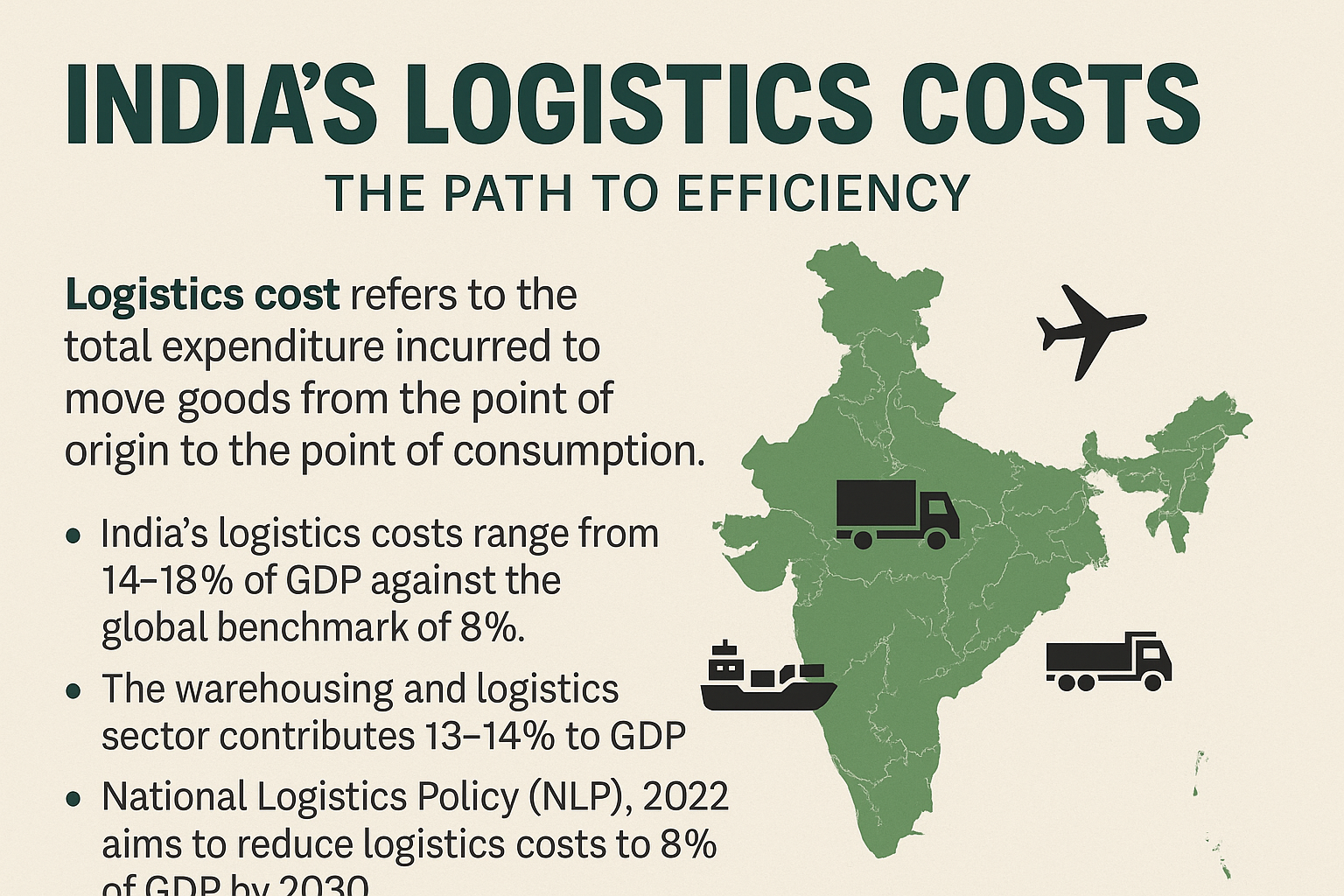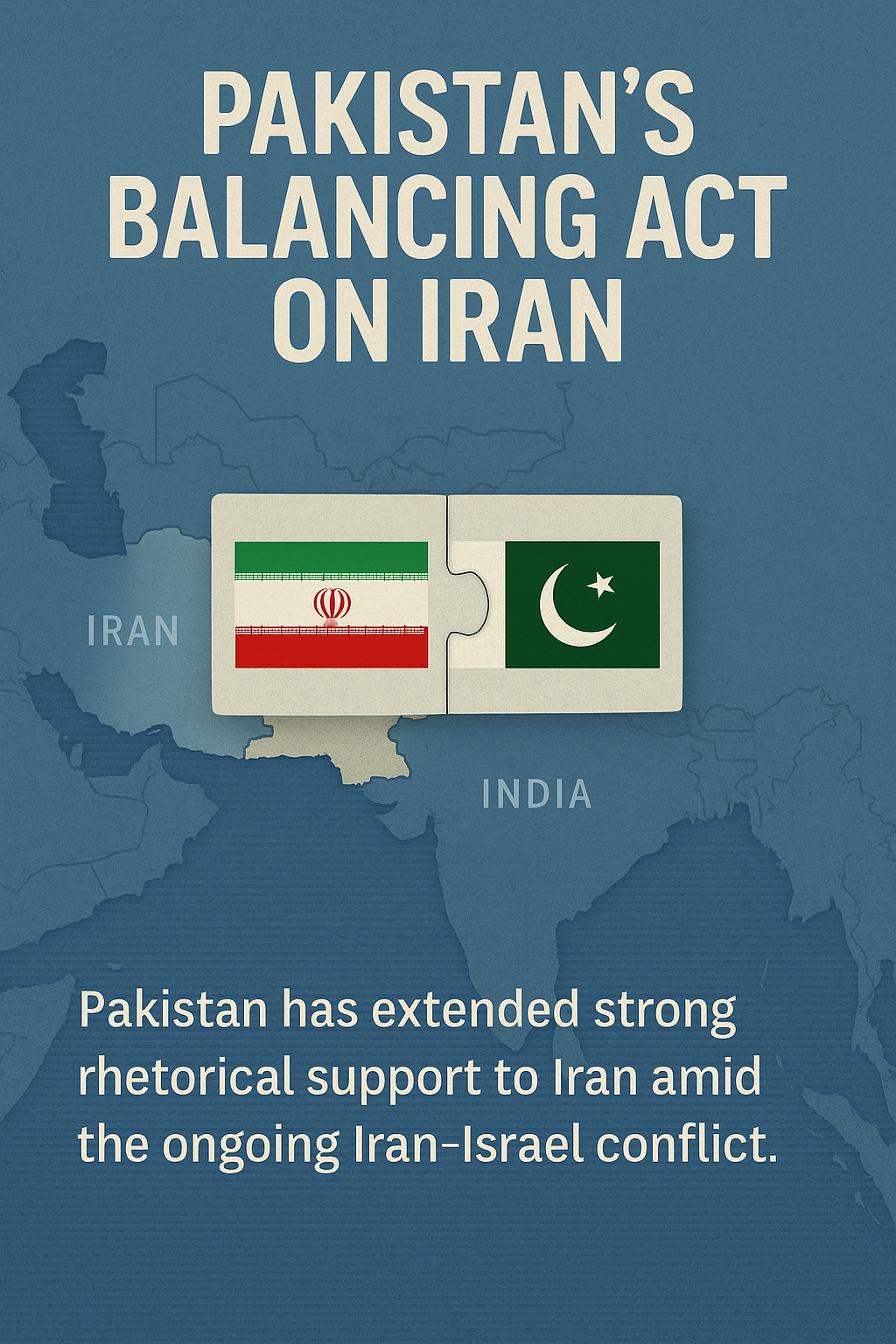
📅 May 3, 2025, Post 3: 🌱 Building a Nation of Entrepreneurs |Mains Essay Attached | Target IAS-26 MCQs Attached: A complete Package, Dear Aspirants!
🌱 Building a Nation of Entrepreneurs

PROJECTS & REPORTS — PETAL 032
📅 May 3, 2025
Thematic Focus: Inclusive Growth, Entrepreneurship, GS III – Economic Development & MSMEs
🌿 Opening Whisper
True growth does not bloom in boardrooms alone—it flourishes in street-side stalls, village workshops, and the bold spirit of everyday dreamers.
🔍 Key Highlights
• The Global Alliance for Mass Entrepreneurship (GAME) and NITI Aayog have formed a strategic partnership to foster entrepreneurship ecosystems in India.
• The focus is on mass entrepreneurship—the widespread creation of small and medium-sized enterprises that generate jobs and social impact, not just profit.
• Pilot sites include Nagpur, Visakhapatnam, and regions of Uttar Pradesh, with tailored interventions.
💡 What is Mass Entrepreneurship?
- Mass Entrepreneurship refers to enabling millions of small-scale entrepreneurs to become job creators.
- Unlike traditional startup models, it promotes inclusive growth—especially in rural, tribal, and underserved communities.
- It links local enterprise with national development goals, emphasizing decentralization and grassroots leadership.
🛠️ Key Principles
- Local Business Empowerment
– Promotes self-reliant businesses in retail, services, manufacturing
– Targets community-specific sectors and market gaps - Social Inclusion & Job Creation
– Women, youth, SC/ST, and rural entrepreneurs prioritized
– Focus on turning job seekers into first-time job creators - Ecosystem Building
– Connects state agencies, financiers, educators, corporates, NGOs
– Encourages community hubs for collaborative entrepreneurship
🤝 GAME + NITI Aayog: Core Objectives
- Pilot Interventions:
– Financing access models for Tier II/III cities
– Capacity-building and digital skilling
– Community-led entrepreneurial platforms - Localized Solutions:
– Address unique barriers (regional demand, capital access, policy gaps)
– Support place-based innovations - Self-Sustaining Hubs:
– Develop entrepreneurial ecosystems that survive beyond initial funding
– GAME has already supported 300,000+ entrepreneurs
🌟 Supporting Government Initiatives
- Startup India (2016):
– Over 17.28 lakh jobs created
– Simplifies compliance, tax holidays, and patent support - Atal Innovation Mission (AIM 2.0):
– ₹2,750 crore for Atal Tinkering Labs and Incubation Centres - Startup India Seed Fund Scheme (SISFS):
– ₹467.75 crore disbursed to 2,622 startups by Dec 2024 - Fund of Funds for Startups (FFS):
– ₹10,000 crore corpus to boost domestic venture capital
⚠️ Current Challenges
• Funding Gaps in smaller towns and niche sectors
• Regulatory Complexity – Taxation, licensing, and compliance burdens
• Market Access Limitations – Weak industry partnerships and global scaling issues
🛤️ Recommendations for the Future
- Expand Financial Ecosystems
– Support early-stage and rural innovation funds
– Promote credit guarantee coverage beyond urban zones - Simplify Regulatory Compliance
– Single-window clearance and reduced documentation - Enhance Market Linkages
– MSME integration with global value chains
– Public procurement portals and e-commerce onboarding
📘 GS Paper Mapping
Prelims:
• GAME, Atal Innovation Mission, SISFS, FFS
• Entrepreneurial Hubs, Startups, MSMEs
Mains:
• GS III – Role of startups in economic growth
• GS II – Role of government in promoting inclusive development
• GS I – Women and youth empowerment through entrepreneurship
🔮 A Thought Spark — by IAS Monk
When millions rise to build not empires, but livelihoods—we witness a revolution, not of technology, but of human dignity.
High Quality Mains Essay For Practice :
Word Limit 1000-1200
If Every Street Sparks a Startup: The Power of Mass Entrepreneurship in India
🌾 Introduction: The Entrepreneur Next Door
Entrepreneurship in India has often been viewed through the lens of elite startups, unicorn valuations, and Silicon Valley dreams. Yet, beyond the glittering headlines, a silent revolution is brewing—from the narrow lanes of Nagpur to the bustling markets of Visakhapatnam. This revolution is led not by tech moguls but by the vegetable vendor who digitizes payments, the women’s cooperative stitching uniforms for schools, and the youth starting a delivery service with a second-hand bike. This is Mass Entrepreneurship—a decentralized, inclusive, and transformational force.
As India charts its journey to a $5 trillion economy, the question is not only how many billion-dollar companies we build, but how many billion small dreams we empower.
🧭 What Is Mass Entrepreneurship? A Paradigm Shift
The concept of mass entrepreneurship shifts focus from the high-tech, venture-backed model of startups to the everyday enterprises that create jobs and meet grassroots needs. It prioritizes scale through numbers, not valuation. It celebrates the tea stall, the garment unit, the village solar technician—all as engines of local economic transformation.
Unlike traditional entrepreneurship, which often thrives in urban hubs with elite access to capital and education, mass entrepreneurship democratizes opportunity. It is a social movement as much as an economic model.
🛠️ Current Landscape: India’s Support Structures and Innovations
India’s startup ecosystem is the third largest in the world. With over 17 lakh jobs created under Startup India, and interventions like Atal Innovation Mission, Startup India Seed Fund, and Fund of Funds for Startups, a robust foundation has been laid.
Yet, many of these supports remain concentrated in metros. This is where the new GAME–NITI Aayog partnership is critical. By piloting entrepreneurship ecosystems in Nagpur, Visakhapatnam, and parts of Uttar Pradesh, the focus shifts toward localized models of empowerment:
- Community-driven business hubs
- Tailored access to finance and skilling
- Mentorship for first-generation entrepreneurs
This decentralization could be the key to true startup democratization.
🌍 Why Mass Entrepreneurship Matters for India
1. Demographic Dividend to Economic Dividend
India has over 1 million youth entering the workforce each month. Mass entrepreneurship offers pathways to transform this surge into productive employment, reducing pressure on formal job markets.
2. Women as Economic Agents
Women’s workforce participation in India remains low. But when empowered as entrepreneurs through self-help groups, livelihood collectives, and digital micro-enterprises, women not only earn—they uplift families and communities.
3. Rural and Tier-II/Tier-III Cities as Growth Engines
Large metros are saturated. Mass entrepreneurship brings distributed growth by enabling economic hubs in semi-urban and rural regions, leveraging local skills and markets.
4. Crisis Resilience and Informality Formalization
COVID-19 showed the vulnerability of wage-dependence. Entrepreneurship helps build resilience through autonomy. Moreover, as micro-enterprises scale, they transition into the formal economy, expanding the tax base and improving governance metrics.
⚖️ Challenges on the Ground
Despite enthusiasm, the road ahead is fraught with barriers:
- Access to Finance: Even with schemes like CGTMSE and MUDRA, only 19% of MSME credit demand was met in FY21. Collateral norms, credit history gaps, and rural banking deficits remain hurdles.
- Regulatory Complexity: From GST filing to Udyam registration, paperwork can overwhelm first-time entrepreneurs.
- Lack of Market Access: Digital platforms exist, but many entrepreneurs lack the digital literacy, network, or logistics capability to reach broader markets.
- Skilling Gaps: India’s vocational training ecosystem is often outdated or disconnected from real market needs.
💡 The Way Forward: Toward a Vibrant Entrepreneurial Nation
1. Place-Based Interventions
Entrepreneurship ecosystems must reflect local culture, skills, and demand. What works in Delhi won’t fit Nagaland. Decentralized support is essential.
2. Credit and Capital Reform
Reforming CGTMSE to be more responsive, and creating state-level micro equity and grant pools could unlock credit for rural enterprises.
3. Public-Private-People Partnerships
Collaborations between local governments, banks, ed-tech firms, and NGOs can form entrepreneurship clusters, modeled after agricultural cooperatives.
4. Digital Market Linkages
The government must invest in vernacular e-commerce tools, offline-to-online transitions, and logistics subsidies for remote sellers.
5. Mentorship at Scale
A national platform of volunteer business mentors, retired professionals, and successful small entrepreneurs could transform risk-averse mindsets.
🔮 A National Culture of Making
In a country where jugaad (creative improvisation) is a cultural norm, entrepreneurship is not alien—it’s ancestral. From craftsmen in Kutch to weavers in Assam, India has long been a nation of makers. The challenge today is to give these creators:
- Legitimacy in policy
- Visibility in media
- Viability in finance and market
Mass entrepreneurship is not a policy add-on. It must become a national movement—as integral to development as digitalization or infrastructure.
✨ Conclusion: When One Rises, All Rise
India doesn’t just need unicorns—it needs a million hummingbirds that create jobs, solve local problems, and leave lasting footprints in their communities.
If every woman with a sewing machine, every graduate with a tech idea, every farmer with a turmeric brand, finds a place in this journey—we’ll not just grow fast, we’ll grow meaningfully.
🪶 Closing Whisper
When a nation helps its smallest dreamer rise, it doesn’t just build businesses—it builds a future woven with dignity.The Satavahana dynasty, often overshadowed in popular memory by the Mauryas or Guptas, was a keystone in the post-Mauryan transition. It filled the power vacuum in the Deccan, stitched together diverse regions, and balanced local autonomy with imperial vision — a model that speaks to India’s diversity even today.
Target IAS-26: Daily MCQs : May 3, 2025
📌 Prelims Practice MCQs
Topic: Global Financial Reforms and Sustainable Development Goals
🧠 MCQ 1: Type-3 — “Which of the above…” Format
Q.1) Consider the following statements regarding Mass Entrepreneurship in India:
1. It focuses only on high-growth tech startups that generate billion-dollar valuations.
2. It encourages community-led micro and small businesses that generate employment.
3. It emphasizes inclusive business creation by involving women and youth from underserved areas.
4. The GAME–NITI Aayog partnership aims to develop mass entrepreneurship only in urban metros.
Which of the above statements is/are correct?
A) Only 2 and 3
B) Only 1 and 4
C) Only 2, 3, and 4
D) All four
🌀 Didn’t get it? Click here (▸) for the Correct Answer & Explanation
✅ Correct Answer: A) Only 2 and 3
Explanation:
Statement 4 is incorrect – The GAME–NITI program emphasizes localized rural/semirural pilot sites like Nagpur, Visakhapatnam, and parts of UP.
Statement 1 is incorrect – Mass entrepreneurship is not focused on elite high-growth startups but on small, community-driven enterprises.
Statement 2 is correct – Local businesses creating jobs are the foundation.
Statement 3 is correct – Focus on women, youth, and marginalized communities.
🧠 MCQ 2: Type-4 — Two Statement Question
Q.2) Consider the following statements regarding the Startup India Seed Fund Scheme (SISFS):
1. It supports early-stage startups by providing funding for proof of concept, prototype development, and product trials.
2. As of December 2024, over 10,000 startups have received assistance through this scheme.
Which of the statements given above is/are correct?
A) Only 1 is correct
B) Only 2 is correct
C) Both 1 and 2 are correct
D) Neither 1 nor 2 is correct
🌀 Didn’t get it? Click here (▸) for the Correct Answer & Explanation
✅ Correct Answer: A) Only 1 is correct
Explanation:
Statement 2 is incorrect – As of December 2024, about 2,622 startups have received benefits, not 10,000+.
Statement 1 is correct – SISFS provides early-stage funding, especially for validation stages.
🧠 MCQ 3: Type-1 — “How many of the above are correct?”
Q.3) Which of the following features are associated with India’s mass entrepreneurship movement?
1. Promotes decentralized, community-driven job creation.
2. Focuses exclusively on high-tech export-oriented units.
3. Seeks to integrate government, finance, education, and civil society in building support ecosystems.
4. Often focuses on Tier II and Tier III cities instead of large metros.
How many of the above statements are correct?
A) Only two
B) Only three
C) All four
D) Only one
🌀 Didn’t get it? Click here (▸) for the Correct Answer & Explanation
✅ Correct Answer:B) Only three
Explanation:
Statement 4 is correct – Focuses on less represented geographies.
Statement 1 is correct – Community-led job creation is a core goal.
Statement 2 is incorrect – Mass entrepreneurship doesn’t emphasize high-tech export units.
Statement 3 is correct – Multi-stakeholder collaborations are key.


















